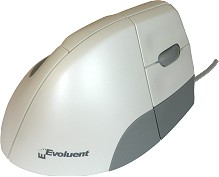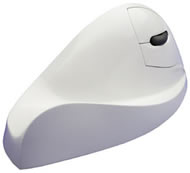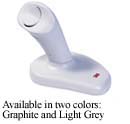
Evoluent's
Vertical Mouse
$49.95
Does this upright mouse pass the "acid test" of ergo equipment? (You know what the acid test is, right?)
I think it was in an issue of PC World that I first saw an ad for Evoluent's Vertical Mouse. Even without their claims that it places the forearm in a more neutral position, I had suspected for a while that an upright orientation to the mouse should be better.
I had considered getting one that resembled a joystick, the 3M Renaissance™ Vertical Mouse, but I guess I just wasn't so optimistic that a joystick orientation would be right for the intense graphics and design work I do. I do user interface design for a financial products company, and although not a graphic artist, I'll go days at a time using the mouse almost non-stop, sometimes in super-zoom views working one pixel at-a-time. I don't know whether it was the stigma (stick-ma?) of the joystick, or my concern that it would require too closed of a grasp, or doubt about precision, but I never pursued it.
Then I saw the VM. I asked the manufacturer if they'd loan me one to review and I've been using it at work for three months now. And here's acid test: After three months of full-time use, I'm not going back to a regular mouse! I knew that I'd take my time before pronouncing any ergo product genuinely beneficial, and I thought I'd be able to form a preliminary decision in a week or two, which I did, but I didn't think it would take me three months to make a committment. Here's my appraisal.
Accommodation Period: Any radical change to such a special, precision tool—which a mouse is—should be expected to require an adjustment period. For me, the adjustment only took a few days to be as efficient. The only hitch was double-clicking; since one clicks somewhat horizontally with a vertical mouse, the double-click action jostled the mouse position out of place. (Keep in mind I set my mouse sensitivity (speed) almost at the maximum, working on a big, 1400 DPI monitor and insisting on super efficiency.) I quickly realized that the VM's third (of 5) programmable buttons was ideal to assign the job of double-clicking. In other words, single-clicking it invokes a double-click. I think it's actually a timesaver and I've become so "programmed" for this that I really miss it at home where I've so far chosen not to convert my family to the vertical world. (I've succeeded recently in teaching them all to say "That's a great idea, dad" when their knee-jerk reaction to most of my zany projects is usually "What's this crazy thing or project," but I can't push change on them too fast.) I'm also really starting to like using the fifth button (on the top left) as a Back button.
Software/Support/Programmability: The software makes it easy to program the buttons. I noticed a little quirkiness with the mouse driver software in the first few days. I think whenever I swapped out another USB mouse (for others to use) the driver got confused. I went to Evoluent's site, saw a new driver, and it is much improved, including a more industry-standard control panel. This no-nonsense online support is a significant confidence factor in assessing ergo products. If I had to jump through hoops to solve a problem I wouldn't recommend a product. A mouse is a hardware "utility"; as such it should be zero maintenance, and almost be as if it's not even there. But software's not the issue, is it? If an ergo device helps with RSI, sufferers would see past the worst software in the world.
Physiological Rationale: Getting back to the RSI evaluation, after a few days it was pretty clear that the upright orientation is more comfortable. How I really recognize that is when I use my prehistoric mouse at home. I can really feel the difference. After about 10 minutes on a conventional mouse, I can feel that I'm pinching with my thumb and pinky and I can detect the twist in my arm. Why don't I—or didn't I—detect this from the previous 10 years of mousing? Because the body is incredibly adaptive. The full answer is what we call the...
#1
Physiological Truth of RSI
For better or worse, the bones and tendons, and to a lesser extent the
muscles (collectively the musculoskeletal system) will try to adapt to
almost any habitual posture and activity. Unfortunately, they will do
this with no accommodation whatsoever to the nervous system, which has
no such adaptability. The nerves weave their way through a harsh, super-high-stress
labyrinth of muscle and tendons and send back the news, as best they can.
As your body struggles to accommodate the monotonous, tiring posture of
keyboard work the news itself gets worse over time, and the nerves themselves,
in their role as messengers, become so battered they can no longer do
their jobs.
So the premise of the VM is that it prevents or lessens the twisting of the two bones in the forearm, resulting in all sorts of benefits because nerves and blood vessels are not as compressed and tendons at the ends of muscles are not as tensed all day. I don't think you have to be a doctor [although I did happen to take a gross anatomy class on human cadavers, but that's another story] for this to make inarguable sense.
So what took three months to decide? Well, I had hoped to tell you that my right arm's ulnar nerve (the one that goes around the outside of the elbow, and has required surgery on my other arm, the left, non-mousing arm) has been freed of symptoms and the VM is "the cure."
But I batter this right arm so badly that there's no mouse on earth that can undo the non-computer damage. First I was chainsawing a tree in my yard for several weeks. After that I've been working on a sculpture lately and first I had to do really tense armwork to cut the mold, and then I used a reciprocating saw as a makeshift vibrator when pouring the castings. (I've come to believe that the micro-impact of vibration is the surest way to bring about my nighttime symptom of waking with a totally numb ulnar nerve. I wonder how badly jackhammer operators fall prey to this problem.) So I realize it's illogical to wait to say "I'm cured and the VM did it." I'm also reminded by previous sufferers to stop hoping for "a cure"; it's not the way RSI works. The solution is putting all the right practices and products together. The bottom line however is that I believe that a vertical mouse is a critical element in the complete solution to RSI.
One last note on products. Why did it take so long for a better mouse? Because manufactured products take their initial form not from the greatest benefit that might be derived, but from the convenience of the manufacturing process. Thus mice were born flat and square, irrespective of your hand's shape and your arm's neutral position.
So what's the final evaluation?
I can work all day with a vertical mouse, and only in the worst case of spending all day or hours at-a-time making icons, do I find myself wringing my hands to get them feeling normal again.
With the Vertical Mouse you will quickly achieve accuracy identical to your conventional mouse. Unlike touchpads and trackballs—I've tried them and they're not good enough for my profession—with the Vertical Mouse there is no compromise in precision of complex mouse actions such as dragging.
If you are a graphic artist, particularly a young one, you must get a Vertical Mouse. If you know a graphic artist, buy them a Vertical Mouse as a present; it's very hard for potential RSI sufferers to invest in prevention. I believe that there is simply no way to predict if a given individual will become susceptible to musculo-skeletal wear-and-tear, but over a 40-year career, you have no reason not to work in the most neutral position. Graphic artists and similar roles will be the worst-damaged computer workers of the future.
The only negative is the slight inconvenience to family members or coworkers who might sit down at a computer with a vertical mouse. But since it's a plug-and-play USB device, you can swap it out quickly with minimal disruption.
I am not compensated by manufacturers other than being provided products for review.
I hope to have a Vertical Mouse available soon in our lending library.
I found two competing products
Quillmouse |
|
3M Renaissance™ Vertical Mouse |
|
Good luck, and let us know what you think.

